Pirate Booty: Can You Dig It?
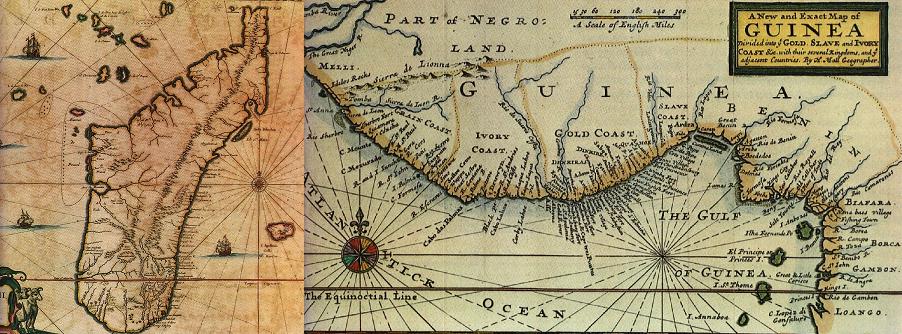
Due in no small part to Stevenson's Treasure Island and Poe's The Gold Bug - buried pirate treasure has had a powerful mythic pull on the imaginations of young and old throughout the world. Little boys dress up in eyepatches and bandanas, digging up the backyard. Rich, eccentric old men piss away their fortunes chasing the cryptic scrawl and red X's of pirate maps real and imagined.
In Under The Black Flag, historian David Cordingly tears down many of the myths (and as he calls it, the 'romance') of Piracy's Golden Age (roughly 1650 to 1725). Chief among these were spurious and fanciful claims of buried treasure. However if he were to give credence to any pirate's penchant for hiding spoils in a fit of paranoia, it would be to that of William "Captain" Kidd. 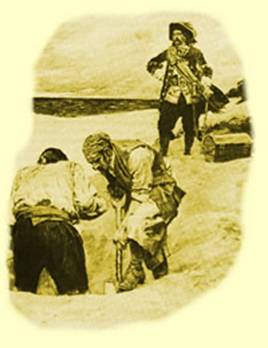
Captain Kidd sailed many ships, from the Quedah Merchant to the Saint Antonio to the Adventure Galley and is thought to have accumulated great wealth taking ships from nations as far flung as India and Armenia. He began his career ironically but perhaps inevitably as a well-heeled pirate hunter, funded by some of the most powerful men in England including the Duke of Shrewsbury and Sir John Somers. Even King William is rumored to have been a 'stealth' backer of Kidd's expeditions.
After allegations of torture and seizure by his crew reached English shores, Kidd was a wanted man. Many locations have been given for the location of his pirate caches: Clarke's Island in the Connecticut River, Fisher's Island and Gardiner's Island off Long Island, Charles Island off Milford, Connecticut in Long Island Sound, the Thimble Islands, Jewell's Island off the coast of Maine and even Madagascar on which he is thought to set up home base for a time - a diving expedition likely discovered the wreck of the Adventure off the island in 1990.
Despite exhaustive searches, extensive research, and untold sums of money pumped into lavish expeditions, no one has ever turned up more than a handful of coins that could likely be linked to Kidd. There exists, however, one mysterious and dangerous place that many people believe may still hold the secret to Kidd's lost fortune.
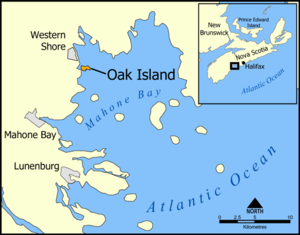 Oak Island lies just off the coast of Nova Scotia in Mahone Bay. It is no more than one-hundred-forty acres in size and yet has captured the imagination of treasure hunters for centuries. The treasure supposedly buried there has rumored links far beyond Kidd. Some believe a shipwrecked Spanish galleon buried its valuables there to return for at a later time. Others link the treasure to the Incas or Mayans -- there are historians who believe a large portion of the vast amounts of precious stones and metals held by these peoples remains unaccounted for. Could it have been taken to places like Oak Island by Europeans sympathetic to the rich history of the 'Indians'?. Given the island's legitimate link to Freemasons (which will be mentioned in greater detail below), it's perhaps not surprising that it has also been mentioned as a possible location for the Holy Grail, and other items associated with the Knights Templar.
Oak Island lies just off the coast of Nova Scotia in Mahone Bay. It is no more than one-hundred-forty acres in size and yet has captured the imagination of treasure hunters for centuries. The treasure supposedly buried there has rumored links far beyond Kidd. Some believe a shipwrecked Spanish galleon buried its valuables there to return for at a later time. Others link the treasure to the Incas or Mayans -- there are historians who believe a large portion of the vast amounts of precious stones and metals held by these peoples remains unaccounted for. Could it have been taken to places like Oak Island by Europeans sympathetic to the rich history of the 'Indians'?. Given the island's legitimate link to Freemasons (which will be mentioned in greater detail below), it's perhaps not surprising that it has also been mentioned as a possible location for the Holy Grail, and other items associated with the Knights Templar.
I will intersperse bits of the legend, accounts of the excavations, and the thoughts of those who have spent a great deal of time attempting to debunk the 'myth' of Oak Island. It is surprising that the usually cutting and conclusive Skeptical Inquirer published an article that to me poses more questions than it answers. Dick Joltes is surely correct that the story contains all the earmarks of buried treasure folklore, but the real, verifiable story is almost as intriguing as any part of the island's legend.
 The Active Mind describes the discovery, the first link of this remarkable chain:
The Active Mind describes the discovery, the first link of this remarkable chain:
One summer day in 1795 Daniel McGinnis, then a teenager, was wandering about Oak Island, Nova Scotia (see Geography) when he came across a curious circular depression in the ground. Standing over this depression was a tree whose branches had been cut in a way which looked like it had been used as a pulley. Having heard tales of pirates in the area he decided to return home to get friends and return later to investigate the hole.
Over the next several days McGinnis, along with friends John Smith and Anthony Vaughan, worked the hole. What they found astonished them. Two feet below the surface they came across of layer of flagstones covering the pit. At 10 feet down they ran into a layer of oak logs spanning the pit. Again at 20 feet and 30 feet they found the same thing, a layer of logs. Not being able to continue alone from here, they went home, but with plans of returning to search more.
It took the three discoverers 8 years, but they did return. Along with The Onslow Company, formed for the purpose of the search, they began digging again. They quickly got back to 30 foot point that had been reached 8 years ago. They continued down to 90 feet, finding a layer of oak logs at every 10 foot interval. Besides the boards, at 40 feet a layer of charcoal was found, at 50 feet a layer of putty, and at 60 feet a layer of coconut fiber.
At 90 feet one of the most puzzling clues was found - a stone inscribed with mysterious writing.
After pulling up the layer of oak at 90 feet and continuing on, water began to seep into the pit. By the next day the pit was filled with water up to the 33 foot level. Pumping didn't work, so the next year a new pit was dug parallel to the original down to 100 feet. From there a tunnel was run over to The Money Pit. Again the water flooded in and the search was abandoned for 45 years.
Joltes believes this early history to be mostly or possibly entirely fabricated, perhaps based on nothing more than a kernel of truth about a sinkhole above a log platform. He states that the two earliest officially documented interviews about early excavation work were from a newspaper called the Liverpool Transcript in 1857. Both Joltes and Nickell believe the extent of this early work essentially 'broke' Oak Island for serious contemporary research because it has been impossible to determine which more or less officially documented findings were original and which were introduced by previous excavators.
A primary feature of interest in the excavation was the inscribed stone supposedly found at a depth of ninety feet. Some stories place the stone as a fireback in the home of a member of the first 'search party', or as a hammering table in a local bookbinding shop. What did the inscription say? A passed-down pictographic cipher (first thought to be ancient Coptic by epigrapher Barry Fell) has been solved - it reads: "Forty Feet Below, Two Million Pounds Are Buried". The specific nature of this inscription seems to clearly identify the purported inscription as a fake, or perhaps a hoax stone being placed by an earlier search party. But Nickell places an extraordinary amount of importance on this aspect of the legend:
Most Oak Island researchers consider the text a hoax (O'Connor 1988, 14), but as Crooker (1993, 24) observes, an inscribed stone did exist, "having been mentioned in all the early accounts of the Onslow company's expedition." Significantly, a cipher message (with key), found in the Secret Vault, is a central aspect of Freemasonry's Royal Arch degree (Duncan 1972, 248-249).
Other artifacts (Finnan 1997, 67, 80, 83) that appear to have ritualistic significance are the stone triangle and great "Christian Cross" as well as "a handworked heart-shaped stone"-Masonic symbols all. Crooker (1993, 179) notes that "a large amount of time and labor" were spent in laying out the cross, but to what end? Could it have been part of a Masonic ritual?
An "old metal set-square" found at Smith's Cove may simply be an innocent artifact, but we recall that three small squares were among the items found in the Secret Vault (Duncan 1972, 243). Indeed, the square is one of the major symbols of Freemasonry which, united with a pair of compasses, comprises the universal Masonic emblem.
Explicitly Masonic, I believe, are certain inscribed stones on the island. These include one discovered at Joudrey's Cove by Gilbert Hedden in 1936. It features a cross flanked by the letter H, said to be a modification of the Hebraic letter for Jehovah, and a prime Masonic symbol known as a Point Within a Circle, representing mankind within the compass of God's creation (Morris n.d., 47; Finnan 1997, 66, 151). Another clearly Masonic stone is a granite boulder found near the Cave-in Pit in 1967. Overturned by a bulldozer it bore on its underside the letter "G" in a rectangle (what Masons term an oblong square). G denotes the Grand Geometer of the Universe-God, the central focus of Masonic teachings-and is "the most public and familiar of all symbols in Freemasonry," observes Mark Finnan (1997, 152). He continues: "The presence of this symbol on Oak Island and its location in the east, seen as the source of light in Masonic teachings, is further indication that individuals with a fundamental knowledge of Freemasonry were likely involved."
Indeed, the search for the Oak Island treasure "vault" has been carried out largely by prominent Nova Scotia Freemasons. I had an intimation of this years ago, but it fell to others, especially Finnan who gained access to Masonic records, to provide the evidence. Freemasonry had come to Nova Scotia in 1738 and, concludes Finnan (1997, 145), "it is almost a certainty that organizers of the first coordinated dig . . . were Masonicly associated." Moreover, he states: "Successive treasure hunts throughout the past two hundred years often involved men who were prominent members of Masonic lodges. Some had passed through the higher levels of initiation, and a few even held the highest office possible within the Fraternity."
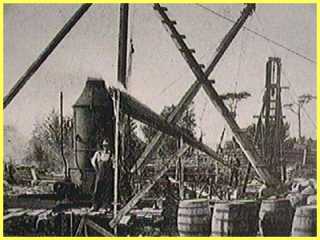 After a period of drilling in which the Truro Company suspected they had drilled through chests, only to bring up a handful of gold links, oak splinters, and strands of coconut husk (coconut was, to say the least, NOT native to Nova Scotia) - they returned:
After a period of drilling in which the Truro Company suspected they had drilled through chests, only to bring up a handful of gold links, oak splinters, and strands of coconut husk (coconut was, to say the least, NOT native to Nova Scotia) - they returned:
The Truro Company returned in 1850 with plans to dig another parallel hole and then tunnel over to the Money Pit. Just like before, as they tunneled over, water began to rush in. They brought in pumps to try to get rid of the water but it was impossible to keep the water out. During the pumping someone noticed that at Smith's Cove during low tide there was water coming OUT of the beach.
This find lead to an amazing discovery - the beach was artificial.
It turns out that the pit designers had created a drain system, spread over a 145 foot length of beach, which resembled the fingers of a hand. Each finger was a channel dug into the clay under the beach and lined by rocks. The channels were then filled with beach rocks, covered with several inches of eel grass, and then covered by several more inches of coconut fiber. The effect of this filtering system was that the channels remained clear of silt and sand while water was still allowed to flow along them. The fingers met at a point inland where they fed sea water into a sloping channel which eventually joined the Money Pit some 500 feet away. Later investigations showed this underground channel to have been 4 feet wide, 2 1/2 feet high, lined with stone, and meeting the Money Pit between the depths of 95 to 110 feet.
To the Truro Company, the answer was now simple - just block off the water flow from the beach and dig out the treasure. Their first attempt was to build a dam just off the beach at Smith's Cove, drain the water, and then dismantle the drain channels. Unfortunately a storm blew up and destroyed the dam before they could finish.
Clearly, noting the "pit designers" ascribes a certain perspective about where myth meets history on Oak Island. How likely is it that a log platform below a sinkhole was mistaken once in the 18th century for a treasure vault? Did subsequent curious men with shovels and eventually 70-ton drills perpetuate the hunt by venturing deeper and deeper, leaving more and more evidence of civilization at every depth? Would frustrated and bewildered gangs of men purposely plant items for later seekers to come across? Might the logical extension of the treasure hunt eventually lead a mile into the earth toward a futile and suicidal end?
Certainly as the excavations became more elaborate, they became more dangerous - shafts combined and collapsed taking men with them, additional sinkholes shifted and opened up without warning, men died by scalding when boilers exploded. It's likely that any loot that may have existed was being continually lowered and spread thin as a result of the 'mad stabs' into the earth - careless digging by generations of greedy treasure hunters noted for their haste and incompetence.
Following Truro, The Oak Island Association attempted to drill down and intersect the main tunnel that seemed to be feeding water into the pit. After coming up empty with the first few drills, they got close enough to reach the pit with an extension but -- more trouble:
However, water began coming in again. A massive bailing operation was then set up when suddenly there was a loud crash as the Money Pit collapsed. It was later theorized that the imagined chests had fallen into a deep void and that the pit may have been booby-trapped to protect the treasure.
It wasn't until the turn of the 20th century that a newly incorporated Oak Island Treasure Company tried again: Further borings found putty levels at 130 and 160 feet, but the major find was in the gap between the putty layers:
A cement vault was discovered. The vault itself was 7 feet high with 7 inch thick walls. Inside the vault the drill first struck wood, then a void several inches high and an unknown substance. Next a layer of soft metal was reached, then almost 3 feet of metal pieces, and then more soft metal. When the drill was brought back up another twist was added to the whole mystery. Attached to the auger was a small piece of sheepskin parchment with the letters "vi"; "ui"; or "wi"; What the parchment is a part of is still in question.
As more and more technology was brought to bear on the battered island, greater depths were bored out, but these advances only yielded more questions. In 1976, a mysterious group called Triton Alliance funded Borehole 10-X, a 237 foot tube sunk deep into the area of the pit. Artificial cavities were supposedly found down to 230 feet but with the endless collapsed shafts of earlier excavations, this is unsurprising. The most sensational result of Triton's work was video imagery from inside a bedrock cavity, harshly lit and difficult to make out. In their accounts, the group claims a "severed hand floating in water", "three chests", and "a human body" were shown upon further analysis of the video. Others who have viewed the footage say it is impossible to tell what the images really are. And for that matter, even if they were what they were purported to be, given the horrifically violent history of 'work' on the Island, a severed hand and a body would be par for the course in a deep inspection of the area.
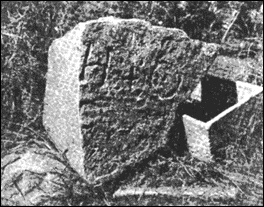
One begins to see the circular approach that searches of this now destroyed island yields. No subsequent drillings have found anything of interest. By all accounts, further disturbance of the area seemed only to serve to drop the entire pit area further into a void, one step ahead of anyone who would wish to uncover its secrets.
That this has happened is not under debate. Whether it was by design or not is another story. Joltes refers to Gordon Fader's interpretation of Oak Island's bathymetry to describe how the elaborate system, supposedly concocted by those who buried the treasure, could be explained by natural formations common to the area. Nickell's account references other engineers and their various hypotheses involving other unspectacular reasons for what had occurred.
It is not surprising that two skeptics would take a stab at what is surely one of the most intriguing buried treasure legends ever told, but as previously mentioned, Nickell's conclusion is barely adequate and would seem to lead to a completely new area of research:
In any event, the evidence indicates a strong Masonic connection to the Oak Island enigma. Others have noted this link but unfortunately also believed in an actual treasure of some sort concealed in a man-made shaft or tunnel (Crooker 1993; Finnan 1997; Sora 1999; Rosenbaum 1973). Only by understanding both pieces of the puzzle and fitting them together correctly can the Oak Island mystery finally be solved.
In summary, therefore, I suggest first that the "Money Pit" and "pirate tunnels" are nothing of the sort but are instead natural formations. Secondly, I suggest that much of the Oak Island saga-certain reported actions and alleged discoveries-can best be understood in light of Freemasonry's Secret Vault allegory. Although it is difficult to know at this juncture whether the Masonic elements were opportunistically added to an existing treasure quest or whether the entire affair was a Masonic creation from the outset, I believe the mystery has been solved. The solution is perhaps an unusual one but no more so than the saga of Oak Island itself.
It is a testament to the intrigue of the legend and the substantiated written history that a publication like Skeptical Inquirer feels the "Freemasons playing a joke" line of reasoning is even a realistic possibility, let alone the 'solution' to the mystery.
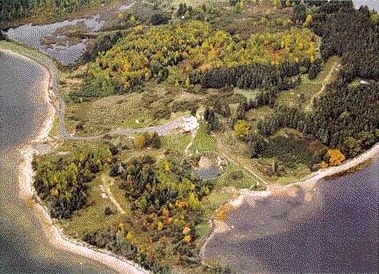
- Login to post comments
